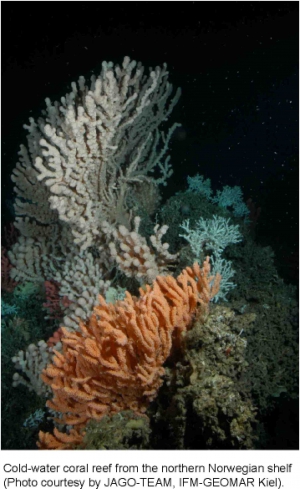Carbonate Mound Research
 In February 1998, the TTR-7 postcruise workshop on „Carbonate mounds and Cold Water Reefs: Deep Biosphere-Geosphere Coupling“ was organised under the auspices of the EC MAST 3 Concerted Action CORSAIRES and IOC UNESCO. It boosted European research projects on modern carbonate mounds and cold-water coral reefs:
In February 1998, the TTR-7 postcruise workshop on „Carbonate mounds and Cold Water Reefs: Deep Biosphere-Geosphere Coupling“ was organised under the auspices of the EC MAST 3 Concerted Action CORSAIRES and IOC UNESCO. It boosted European research projects on modern carbonate mounds and cold-water coral reefs:
- FP5 tryptich GEOMOUND, ECOMOUND and ACES
- RTN EURODOM
- ESF EuroMARGINS project MoundForce
- FWO project GeNesis
- ESF EuroDIVERSITY project MiCROSYSTEMS
- ESF EuroMARC project CARBONATE
- and various national projects
As cold-water coral research moved on, it progressively bifurcated into:
- a biological string, focusing on the cold-water coral ecosystems and largely driven by conservational issues with prominent projects like HERMES, CORAMM, CoralFish, HERMIONE, TRACES, etc., and
- a geological string, which endeavours to unravel the significance of carbonate mounds as unique paleoenvironment recorders and as giant biogeochemical reactors.
Flagships of European oceanography have surveyed these mounds - some of them year after years in tens of cruises. About all tools of modern ocean science have been deployed: high-resolution 2D/3D seismic, deeptow seismic, surface and ROV-born multibeam bathymetry, sidescan sonar imaging, coring devices from multicorers to the Calypso giant piston corer, remotely operated vehicles (ROV), manned submersible JAGO, landers, moorings, etc.
In the latter development, IODP Exp. 307 (2005) on Challenger Mound off Ireland (proposal 573-full) stands as a milestone. The discovery of carbonate mounds amidst giant mud volcanoes off Morocco in 2002 led to a new proposal (IODP 673-Full). The build-up of mounds through the interplay of planktonic, benthic and/or microbial consortia with sediments and fluid flow exemplifies Geoshere-Biosphere coupling processes in the Ocean, which are closely as ancient as Life on Earth itself.